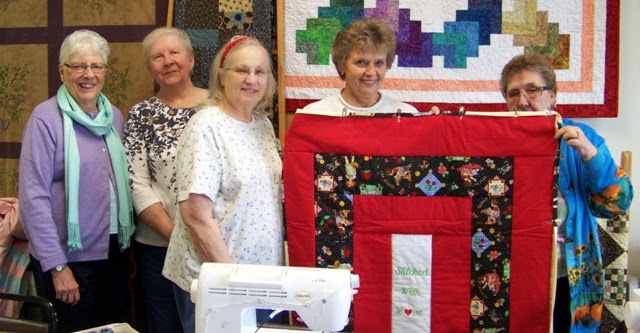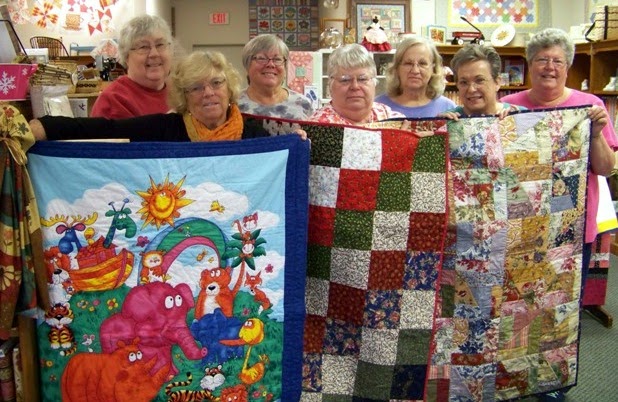West Michigan Quilt Guild brought Sharon Schamber to Grand Rapids this week. Sharon is a well known author, speaker, teacher, and quilter. She spoke at the Guild on Tuesday evening and taught classes on Tuesday and Wednesday. I was fortunate in that I got to attend her “Domestic Quilting Feather Abundance” class. Not only was it a fun day, but I learned so much that my head is still spinning. Sharon, (shown above) is warm and caring and is an excellent teacher who is willing to share her years of experience and knowledge. I’ll try to pass along some of what I learned today.
We students were all so nervous at the beginning of class that Sharon had to tell us to calm down, relax, and enjoy the day. She said that most quilters are Alpha quilters and want you to get right to the point. That is what she did. She said that there are only four shapes that you need to know when you do free motion quilting: The scallop, soft ess, tear drop, and scroll.
She first taught us how to baste. In the past I have hated basting, but her technique made it fast and fun. I hope you can see in the picture, even the basting looks good. Sharon uses boards when she bastes. You’ll have to take her class or go to her website to see what I’m talking about. I had no idea what that was all about when my supply list said to bring specific size boards. Since I didn’t get any pictures I can’t explain. Above Sharon demonstrates how to use a slider and hoop when doing free motion quilting. She talked about length of the feather spine, size of the feathers, etc., and how they can all be related to sizes of your own body part. TIP: For instance, the average feather size is the size on your index finger.
TIP: Did you know that to determine the size needle you need, you hold three strands of thread side by side and if they fit through the eye of the needle that is the size needle you need.
TIP: Did you know that static builds when you free motion quilt and that a Teflon sheet on your machine beneath the fabric will eliminate that static. Static build up could destroy the computer in your machine.
Sharon also talked about stopping and scoring. What is that? Sounds like a term a man would use. Sharon says that when you first start out quilting you should sew one feather and stop, use your stiletto or bone to mark the next feather (score it). You should do this marking three times to build body memory, and only then should you make the next feather. Then you stop again and repeat the process before you move to the next feather. Sounds tedious, but it actually works. I notice that I made much better feathers when I did this. Above a student has stopped to score her next feather.

Sharon told us about thread also. TIP: She said that your thread should be stored in a tight box and kept in a dark place to make it last longer. You should not store your thread on a rack where it is exposed to light and air. She said that thread does get dry; in fact, the way it is manufactured today makes thread dry. Do you ever have the problem with thread breaking? Dry thread might be the cause. In order to compensate for this, Sharon dips a spool of thread into a jar of mineral oil, takes it right out, dries it with a paper towel, and it is immediately ready to use. This makes your machine run much smoother/quieter, and you will notice that you don’t get as much lint.
Connie (above) works on a feather. TIP: Sharon says to choose your threads according to what you want to do. European threads will bury into your fabric giving an heirloom look. Other threads tend to lay on top of the fabric and should be used for decorative purposes.
These are not Connie's feet. These belong to another student but I thought this was so darn cute, I had to take a picture of it. Despite the nervous tension at the beginning of the class, students soon became comfortable and got down to the business of making feathers. TIP: Sharon recommends Quilter’s Dream for batting. She likes wool best.
Look at what Betsy did today. Wow, is she a fast learner or what? She did wonderful job in such a short time. TIP: If you are going to stitch in the ditch on your quilt, do not do it first. Do your decorative stitching first, then do your stitch in the ditch.
Here Sharon demonstrates on a white board how to quilt in a triangle.
Tomorrow I will show pictures of Sharon’s prize winning quilt. You will be amazed!
Check out Sharon's website here for some free stuff. ♥
Stay Positive!
Caroll
























